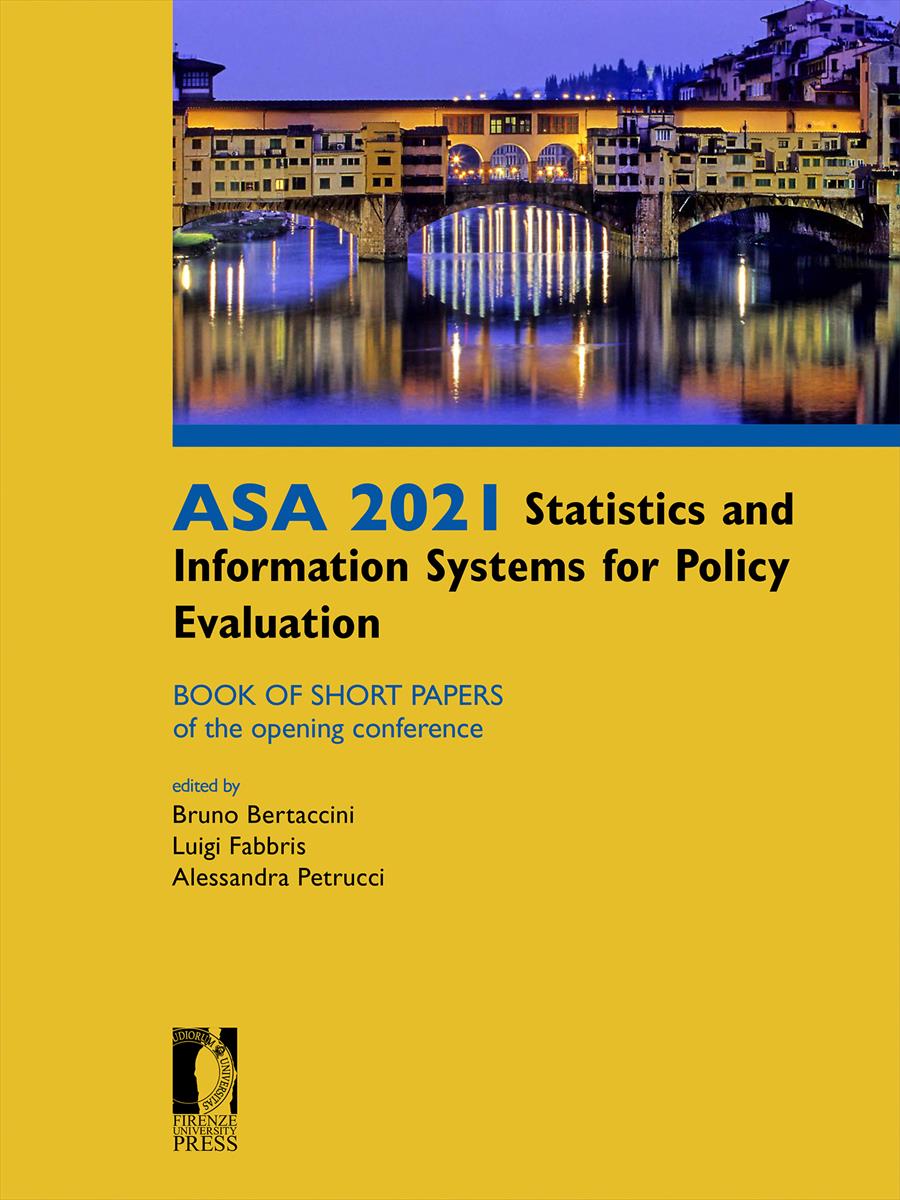- ASA 2021 Statistics and Information Systems for Policy Evaluation
- Edited by Bruno Bertaccini, Luigi Fabbris, Alessandra Petrucci
Determinants of spatial intensity of stop locations on cruise passengers tracking data
- Nicoletta D’Angelo
- Mauro Ferrante
- Antonino Abbruzzo
- Giada Adelfio
- © 2021 Author(s) |
- CC BY 4.0
- DOI: 10.36253/978-88-5518-304-8.31
This paper aims at analyzing the spatial intensity in the distribution of stop locations of cruise passengers during their visit at the destination through a stochastic point process modelling approach on a linear network. Data collected through the integration of GPS tracking technology and questionnaire-based survey on cruise passengers visiting the city of Palermo are used, to identify the main determinants which characterize their stop locations pattern. The spatial intensity of stop locations is estimated through a Gibbs point process model, taking into account for both individual-related variables, contextual-level information, and for spatial interaction among stop points. The Berman-Turner device for maximum pseudolikelihood is considered, by using a quadrature scheme generated on the network. The approach used allows taking into account the linear network determined by the street configuration of the destination under analysis. The results show an influence of both socio-demographic and trip-related characteristics on the stop location patterns, as well as the relevance of distance from the main attractions, and potential interactions among cruise passengers in stop configuration. The proposed approach represents both improvements from the methodological perspective, related to the modelling of spatial point process on a linear network, and from the applied perspective, given that better knowledge of the determinants of spatial intensity of visitors’ stop locations in urban contexts may orient destination management policy.
- Keywords:
- Gibbs point processes,
- GPS tracking data,
- Cruise tourism,
- Linear network,
- Spatial intensity,
University of Palermo, Italy - ORCID: 0000-0002-8878-5986
University of Palermo, Italy - ORCID: 0000-0003-1287-5851
University of Palermo, Italy - ORCID: 0000-0003-2196-3570
University of Palermo, Italy - ORCID: 0000-0002-3194-4296
- Abbruzzo, A., Ferrante, M., & De Cantis, S. (2020). A pre-processing and net- work analysis of GPS tracking data. Spatial Economic Analysis, pp. 1–24. DOI: 10.1080/17421772.2020.1769170
- Baddeley, A., Nair, G., Rakshit, S., McSwiggan, G., & Davies, T.M. (2020). Analysing point patterns on networks – a review. Spatial Statistics, 100435.
- Cooper, C. P. (1981). Spatial and temporal patterns of tourist behaviour. Regional Studies, 15(5), pp. 359–371.
- East, D., Osborne, P., Kemp, S., & Woodfine, T. (2017). Combining GPS & survey data im- proves understanding of visitor behaviour. Tourism Management, 61, pp. 307–320.
- Ferrante, M., De Cantis, S., & Shoval, N. (2018). A general framework for collecting and analysing the tracking data of cruise passengers at the destination. Current Issues in Tourism, 21(12), pp. 1426–1451.
- Illian, J.B., & Hendrichsen, D. K. (2010). Gibbs point process models with mixed effects. Environmetrics, 21, pp.341–353.
- Jaakson, R. (2004). Beyond the tourist bubble?: cruiseship passengers in port. Annals of tourism research, 31(1), pp. 44–60.
- Kallenberg, O. (1984). An informal guide to the theory of conditioning in point processes. International Statistical Review/Revue Internationale de Statistique, pp. 151–164.
- Lew, A., & McKercher, B. (2006). Modeling tourist movements: A local destination analysis. Annals of tourism research, 33(2), pp. 403–423.
- Liu, B., Huang, S. S., & Fu, H. (2017). An application of network analysis on tourist attractions: The case of Xinjiang, China. Tourism Management, 58, pp. 132–141.
- Mateu, J., Moradi, M., & Cronie, O. (2019). Spatio-temporal point patterns on linear networks: Pseudo-separable intensity estimation. Spatial Statistics, 100400.
- Meekan, M. G., Duarte, C. M., Ferna´ndez-Gracia, J., Thums, M., Sequeira, A. M., Harcourt, R., & Egu´ıluz, V. M. (2017). The ecology of human mobility. Trends in Ecology Evolution, 32(3), pp. 198–210.
- Moradi, M.M., Cronie, O., Rubak, E., Lachieze-Rey, R., Mateu, J., & Baddeley, A. (2019). Resample-smoothing of voronoi intensity estimators. Statistics and computing, 29, pp. 995– 1010.
- Moradi, M.M., & Mateu, J. (2020). First- and second-order characteristics of spatio-temporal point processes on linear networks. Journal of Computational and Graphical Statistics, 29(3), pp. 432–443.
- Russo, A. P. (2002). The ‘vicious circle’ of tourism development in heritage cities. Annals of tourism research, 29(1), pp. 165–182.
- Shoval, N. (2008). Tracking technologies and urban analysis. Cities, 25(1), pp. 21–28.
- Shoval, N., & Ahas, R. (2016). The use of tracking technologies in tourism research: the first decade. Tourism Geographies, 18(5), pp. 587–606.
- Shoval, N., & Isaacson, M. (2009). Tourist mobility and advanced tracking technologies. Rout- ledge, London.
- Stopher, P. (2012). Collecting, managing, and assessing data using sample surveys. Cambridge University Press, Cambridge.
- Van Lieshout, M. N. M. (2000). Markov point processes and their applications. World Scientific
- Zheng, W., Huang, X., & Li, Y. (2017). Understanding the tourist mobility using GPS: Where is the next place?. Tourism Management, 59, pp. 267–280.
Chapter Information
Chapter Title
Determinants of spatial intensity of stop locations on cruise passengers tracking data
Authors
Nicoletta D’Angelo, Mauro Ferrante, Antonino Abbruzzo, Giada Adelfio
Language
English
DOI
10.36253/978-88-5518-304-8.31
Peer Reviewed
Publication Year
2021
Copyright Information
© 2021 Author(s)
Content License
Metadata License
Bibliographic Information
Book Title
ASA 2021 Statistics and Information Systems for Policy Evaluation
Book Subtitle
Book of short papers of the opening conference
Editors
Bruno Bertaccini, Luigi Fabbris, Alessandra Petrucci
Peer Reviewed
Publication Year
2021
Copyright Information
© 2021 Author(s)
Content License
Metadata License
Publisher Name
Firenze University Press
DOI
10.36253/978-88-5518-304-8
eISBN (pdf)
978-88-5518-304-8
eISBN (xml)
978-88-5518-305-5
Series Title
Proceedings e report
Series ISSN
2704-601X
Series E-ISSN
2704-5846
